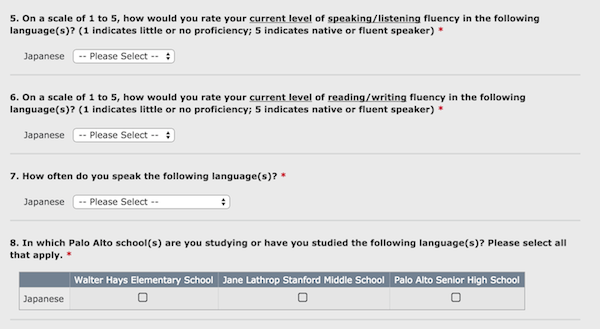The Palo Alto Unified School District is conducting surveys to incorporate best practices to adopt into world language programs and course alignment policies.
According to Associate Supt. Charles Young, the district hired Hanover Research, a global informational services firm, to coordinate two separate studies — one on world languages and the other on course alignment. After collecting the surveys, the firm will give the district a list of recommendations and strategies involving curriculum.
“They [Hanover Research] will put together a report for us with a summary of the findings and some potential meaning behind the survey information,” Young said. “We’ll have conversations with the board and staff and see what kind of goals and actions we think that we might want to set in relation to that data to inform our practices next year.”

In a letter to parents, Supt. Max McGee informed the community about the intent of the surveys.
“Working with Hanover Research will better enable us to maintain a high degree of accountability to ourselves, our students, and our community, while continuing to offer a rich and challenging academic environment for all students,” McGee said.
The world language survey is being taken by students, staff and parents. The student survey focuses on the experiences that high school students have had with language classes throughout their years in the district, including elementary and middle school immersion programs.
The district is also looking to see if it should further expand its world language programs, especially at the elementary school level, according to Young.
The course alignment survey is only administered to students and teachers. The survey inquires about alignment in the four core subject areas: math, English, history and science. According to Young, the goal of this study is to understand students’ experiences in their classes around course expectations, assessments and homework.
Although Young says that students with different teachers should have varied experiences within a given course, the district hopes to create a unified experience in the four core classes by outlining the best practices of each course.
“We would never want or expect every teacher to do everything exactly the same thing on every given day,” Young said. “We know that’s not good teaching.”
According to Young, the intent of the surveys is not to criticize staff or students. Rather, the surveys have been developed to continue to reflect on district policies.
“The question of alignment experience for students has been an interest that’s been shared in the community for a while,” Young said. “It’s not about being evaluative or punitive.”
Young said that the surveys will surface many strengths that the current curriculum has to offer and also inform the district on how to improve certain policies.
“It’s all about how we continue to do our work and make it the best experience for our students,” Young said.

